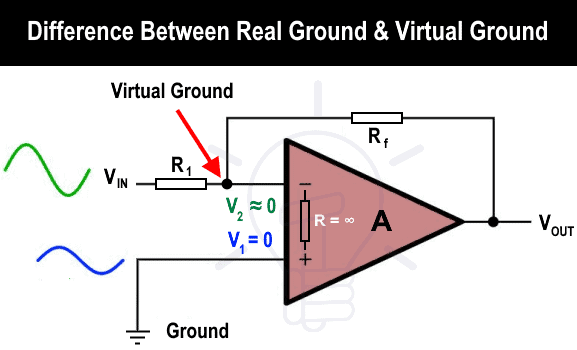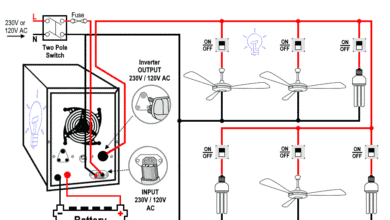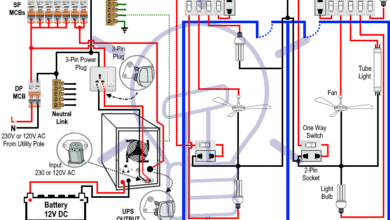Difference Between GND, 0VDC, Common and Virtual Ground
Comparison Between Ground (GND), Chassis Ground, 0VDC, Common (COM) and Virtual Ground
The terms GND (Ground), Virtual GND, 0VDC, and Common (COM) may appear similar and are sometimes used interchangeably, which can lead to confusion in electrical and electronic circuits. However, their meanings and functions differ depending on the circuit requirements, design, and application.
Ground (GND):
Ground (GND) is a reference point in an electrical circuit from which voltages are measured. It may be connected to the earth (physical ground) or may simply be a common return path for current.
There are multiple types of grounding.
- Earth Ground & (Chassis Ground) represented by the symbol of ⏚ is physically connected to the Earth using a grounding rod. Chassis Ground is normally connected to the metallic body or frame of a device. This type of grounding is used in electrical power systems and household wiring to ensure safety and protect both equipment and personnel from electric shock hazards.
- Signal Ground is typically not connected to earth and used in electronic circuits as a reference point for signal voltages.
- Power Ground Serves as the return path in power circuits. and an be connected to earth in some systems based on design, requirement and applications.
Examples of ground in AC power systems is a safety connection to prevent shocks. In DC circuits, GND is often used as a 0V reference for measurements.
- Related Post: Difference Between AC Ground and DC Ground
Virtual Ground
A Virtual Ground is an artificially created 0V reference point in a circuit that is not physically connected to ground. Virtual ground allows single-supply circuits to simulate a split-supply operation and used in op-amp circuits to create a midpoint reference voltage.
For example, in a single-supply op-amp circuit (e.g., 9V battery): Instead of ±4.5V, a virtual ground at 4.5V is created. This allows the op-amp to handle AC signals symmetrically.
Another example of the virtual ground concept is in a negative feedback configurations when both input terminals don’t acts as ground while the the voltage level at both terminals are same.
- Related Post: Difference Between Real Ground and Virtual Ground
Zero-Volt DC (0VDC)
Zero Volt DC (0V) is the reference voltage level in a DC circuit. It is not necessarily the same as Earth Ground but is used as the zero potential point in a circuit.
0VDC is the negative terminal of the power source used in a single power supply system (e.g., 5V DC circuits). In a dual power supply (e.g., ±12V systems), 0VDC is the midpoint reference.
For example, in a 5V DC circuit, you might have:
- +5V (positive voltage)
- 0VDC (reference voltage)
- Ground (which could be the same as 0VDC but not always)
Common (COM)
Common (COM) refers to a shared connection point in a circuit that serves as a reference for multiple components.
In DC systems, common is the return path for current to the source or ground reference. Commonly, Negative (-Ve) terminal is considered the Common wire and represented by Black color coding.
In an AC circuit, a “common wire” refers to the neutral wire, which acts as the return path for electrical current, carrying the current back to the power source after it flows through the appliance or device. Essentially, it is used to complete the circuit. Common is usually the neutral wire in AC system identified by White (in NEC) and Blue (IEC) color coding in most household wiring systems.
For example: In multimeters, the black probe is usually connected to COM (common ground) for measurements. In electrical panels and load centers, the neutral bus bar is sometimes referred to as “common”. In Three-Phase systems, the common point in a Y-connection (star connection) is the neutral.
- Related Post: Difference Between Grounding, Earthing and Bonding
Comparison Table:
| Term | Definition | Connection to Earth? | Example Use |
| Ground (GND) | Reference point for voltage | Sometimes | Power circuits, safety grounding |
| 0VDC | Zero-voltage reference in a DC circuit | Not always | Electronic circuits, battery-powered devices |
| Virtual Ground | Artificial midpoint voltage | No | Op-amp circuits, single-supply systems |
| Common (COM) | Shared reference point in AC/DC circuits | Sometimes | Multimeters, neutral wires |
Resources:
- Can you Combine AC and DC Ground in a Solar Installation?
- Should You Connect GND and 0VDC? Combined AC & DC Grounding
- Why Doesn’t DC System Require a Grounding System Similar to AC System?
- How Does the Grounding System Work in Aircraft & Submarines?
- Will I Get an Electric Shock If I Touch the Ground Wire?
- Is It Possible to Get Electrocuted by an Electric Vehicle?
- What Happens if a Battery is Connected to the AC Supply?
- Why is the Grounding Wire Bare and Not Insulated?
- Why is the Ground Wire Size Smaller than the Hot Wire?
- Why is the Ground Wire Always Positioned Above the Overhead Power Lines?
- Why Must Neutral and Ground Wires Be Bonded in the Main Panel?
- Why are Neutral and Ground Wires Separated in a Subpanel?
- Why are Salt and Charcoal Added in Earthing Pit for Grounding?
- Why Can’t We Store AC in Batteries instead of DC?
- Difference between AC and DC (Current & Voltage)
- Difference Between AC and DC Resistance?








